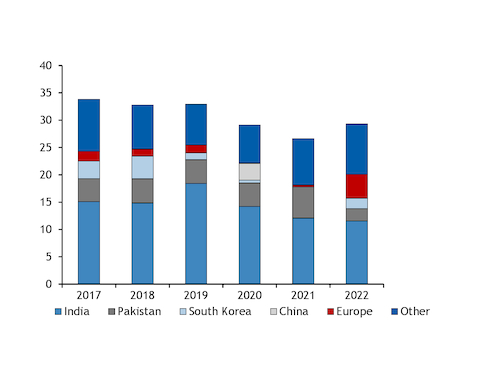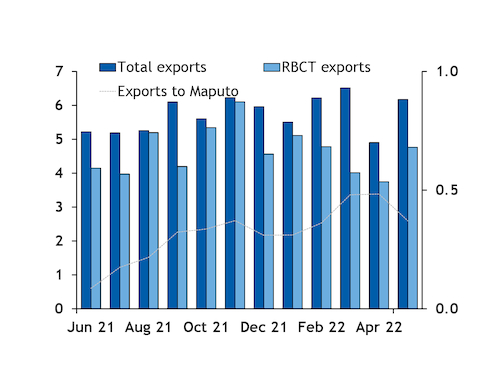South African coal exports rose by 18pc on the year in May, prompted by a sharp increase in deliveries to Europe, which more than offset a drop in volumes to India and Pakistan.
And provisional shipping data show that volumes also rose on the year in June, before dropping sharply in July amid annual maintenance work by Transnet Freight Rail (TFR).
Total exports from South Africa rose from 5.2mn t in May 2021 to 6.2mn to in May 2022, customs data show, while January-to-May exports rose by 9pc to 29.3mn t.
The increase in May was driven by a sharp rise in exports to Europe. Total exports to the continent reached 1.26mn t in May, down by 15pc on the month but up nearly four-fold from May 2021.
The trend continued into June, with South African exports to Europe totalling 1.1mn t, up from 216,000t in the same month a year earlier, shipping data show. Flows to Europe remained firm this month and are set to continue at a high level for the foreseeable future.
European coal imports surged to a four-year high between January to July, spurred by a need to replenish stocks ahead of the Russian coal embargo which comes into force on 10 August.
But overall European import volumes could fall into August and September, as the EU embargo kicks in and Russian inflows come to a halt.
Deliveries to India and Pakistan slump
South African exports to India and Pakistan slumped in May, as buyers in India continued to prioritise competitively priced Russian coal and buyers in Pakistan targeted product from landlocked Afghanistan.
South Africa exported 2.4mn t to India in May, down by 8pc on the year, while deliveries to Pakistan fell by 61pc on the year to 394,000t.
Pakistani imports have been impacted by a rapidly depreciating rupee against the dollar in 2022, which has weakened the country's industrial output and purchasing power.
RBCT volumes fall
But while total volumes from South Africa rose between January and May, exports from Richards Bay Coal Terminal (RBCT) fell.
January to May exports from RBCT totalled 22.4mn t, down by 6pc on the year. This compares with a 9pc rise in total South African exports over the same period.
The RBCT shortfall has been picked up by higher exports from other South African terminals, such the as Richards Bay dry bulk and multi-purpose terminals, the Durban terminal, and by deliveries from the Mozambique-based Grindrod Mozambique Limitada (GML) and Matola Drybulk Terminals (TCM), market sources said.
South African exports to Mozambique rose by 258pc between January and May to 2.9mn t in 2022, customs data show (see chart).
Meanwhile, exports from RBCT are set to remain limited by low storage volumes, which fell sharply during TFR's annual maintenance period on the North Corridor coal export line, which ran from 12-22 July. Inventories fell by 20pc on the week to 2.29mn t on 25 July.
Production in South Africa has also stuttered in 2022. In May, production was around 18.8mn t, up by 2mn t on the month, but down from last May's 20.3mn t.




